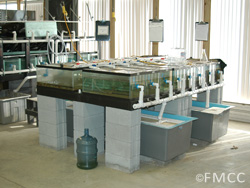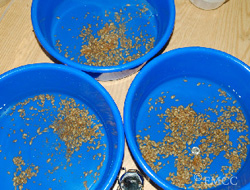Since freshwater mussels have a unique life history, requiring the use of a fish to complete their life cycle, the process of producing juvenile mussels begins by collecting suitable host fish from the river and holding them in captivity until gravid female mussels can be found. In the laboratory, the larvae (glochidia) in the gills of the female mussel are flushed out using a hypodermic needle filled with water. This non-lethal method allows us to return females to the river once her progeny have been removed. The larvae can number more than 200,000 per female. These larvae are then introduced into a bucket holding the host fish, and aeration is used to keep the water agitated to allow larvae to attach to the gills of the fish. After 30 minutes to 1 hour of exposure, the fish are moved to large aquaria where the attached larvae begin the transformation process, which requires 2-3 weeks depending on water temperature. Once these young juveniles drop from their host fish, they are collected by siphoning the tank bottoms. They are put in small containers or in re-circulating streams at the FMCC mussel culture facility, where they are fed cultured algae and/or pond water until a desired size is achieved for release to the wild, usually 1-2 years of age.

Recirculating water juvenile mussel culture system.

Early juvenile mussels
